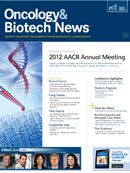Publication
Article
Oncology & Biotech News
Unexpected Mutations Doom Therapy for Glioblastoma
Author(s):
Unexpected target mutations likely doomed a proven therapeutic approach to lung cancer in a test against glioblastoma.
Ingo K. Mellinghoff, MD
Unexpected target mutations likely doomed a proven therapeutic approach to lung cancer in a test against glioblastoma, studies of tumor tissue samples suggest.
Glioma-specific mutations in epidermal growth factor receptor (EGFR) conferred resistance to EGFR inhibitors that have demonstrated activity in EGFR-mutant lung cancer, specifically erlotinib (Tarceva). In contrast, glioblastoma exhibited addiction to a specific EGFR signaling kinase in cells that expressed mutations sensitive to type II inhibitors, which include lapatinib (Tykerb), Ingo K. Mellinghoff, MD, said at a press conference during the 2012 AACR Annual Meeting. Mellinghoff et al’s research was simultaneously reported in the AACR journal Cancer Discovery. “
EGFR mutations in glioblastoma occur almost exclusively in the extracellular domain of the receptor,” said Mellinghoff, a neuro-oncologist at Memorial Sloan-Kettering Cancer Center in New York City. “In contrast, mutations in lung cancer usually map to the intracellular domain of the receptor.”
The findings suggest that EGFR-targeted therapy development in glioblastoma should focus on type II inhibitors, he added.
In contrast to the clinical experience in lung cancer, EGFR inhibitors have produced disappointing results in glioblastoma. The therapeutic failure had puzzled scientists because about 40% of glioblastoma cells harbor EGFR oncogenic mutations. In an effort to solve the puzzle, Mellinghoff and colleagues examined EGFR signaling in glioblastoma cell lines.
Upon sequencing the EGFR coding region in a panel of glioblastoma cells, the investigators identified two cell lines with EGFR mutations in the extracellular (EGFR-EC) domain. EGFR mutations in lung cancer occur in the intracellular kinase domain, Mellinghoff noted.
The next step was to determine whether cells with EGFR-EC mutants required EGFR for survival (ie, were “addicted”). If so, the cells might be hypothesized to exhibit the same sensitivity to EGFR inhibition as observed in lung cancer.
Induction of acute infection in specific areas of EGFR mRNA by means of retroviral RNA led to loss of EGFR protein expression and cell death. The same technique had no effect on human astrocytes or on two glioblastoma cell lines without EGFR-EC mutations.
Investigators then exposed the cells with extracellular mutations to a type II EGFR kinase inhibitor (HKI-272), which irreversibly inhibits EGFR and other members of the ErbB family. The inhibitor induced cell death in mutant cells but not in glioblastoma cells with wild-type EGFR, nor in lung cancer cells or astrocytes.
In subsequent experiments, Mellinghoff and colleagues found that glioblastoma cells with EGFR-EC mutations exhibited greater sensitivity to lapatinib than to erlotinib. Both drugs led to dosedependent reductions in EGFR phosphorylation, but lapatinib demonstrated substantially greater potency against all EGFR-EC mutants. In contrast, erlotinib had more potent activity against lung cancer cells with EGFR intracellular mutations.
Though more potent at inhibiting the EGFR-EC mutants, lapatinib did not achieve complete inhibition.
“Near-complete EGFR inhibition is critical to induce cell death in EGFR-EC—mutant glioblastoma cells,” he said. “Intratumoral lapatinib concentrations were below the concentrations that induce cell death in vitro.”







%20(2)%201-Recovered-Recovered-Recovered-Recovered-Recovered.jpg?fit=crop&auto=format)

%20(2)%201-Recovered-Recovered-Recovered-Recovered-Recovered.jpg?fit=crop&auto=format)
%20(2)%201-Recovered-Recovered-Recovered-Recovered-Recovered.jpg?fit=crop&auto=format)